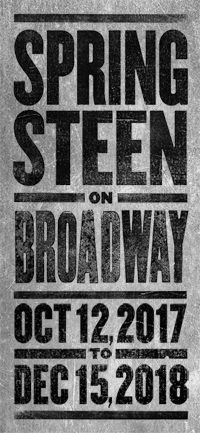 If Springsteen on Broadway had a curtain, it would come down for the final time tomorrow. After 14 months, 236 performances with no understudy in sight, and a Special Tony Award, Bruce Springsteen leaves behind (as he's noted from the stage) the only five-days-a-week job he's ever held. At virtually the same time, audiences everywhere can experience the smash of the season for an insignificant fraction of the not-insignificant Broadway ticket cost — you don't even have to be deemed a Verified Fan.
If Springsteen on Broadway had a curtain, it would come down for the final time tomorrow. After 14 months, 236 performances with no understudy in sight, and a Special Tony Award, Bruce Springsteen leaves behind (as he's noted from the stage) the only five-days-a-week job he's ever held. At virtually the same time, audiences everywhere can experience the smash of the season for an insignificant fraction of the not-insignificant Broadway ticket cost — you don't even have to be deemed a Verified Fan.
With today's release of the Springsteen on Broadway soundtrack, this is by far the quickest Columbia Records has ever followed up a Springsteen live venture with a corresponding document. And over the weekend, Thom Zimny's snout-to-tail Springsteen on Broadway film will have a similar global reach, bowing on Netflix December 16, where it will stream for the foreseeable future.
Springsteen on Broadway is dead — long live Springsteen on Broadway!
Even if you couldn't experience your own Incident on 48th Street, frequent visitors to this site probably have a decent sense of Springsteen on Broadway, its nuts and bolts. Inspired by Springsteen's Born to Run memoir (and further by a private, summational farewell show at the White House in the final days of the Obama administration), Springsteen on Broadway is less of a concert than a soliloquy with piano and guitar. It's a theatrical performance befitting the Great White Way. It's a one-man show — except for most nights, when the one man was joined by his one woman. It's an intimate night with one of music's most larger-than-life figures, a stadium performer inviting you into his living room. It's a showcase for the showman's multitude of talents, from storytelling to rocking and rolling, song arranging, and comedic styling. It's an acoustic show. It's spoken word. It's a dark ride. It's a revealing, autobiographical recontextualization of some of Springsteen's most well-known and well-loved songs, tracing a path from boyhood to manhood, or from innocence to experience, or from a narrow scope of vision to a broad one, or all of the above.
It's the better part of a grand, depending on when and how you procured your tickets. Or at least, it was. (Though let's hear it for the cheap seats, $75 for the balcony in the daily Lucky Seat lottery drawing, we should all be so lucky.)
From "Growin' Up" at the outset to "Land of Hope and Dreams" at night's end — with "Born to Run" as encore and benediction — on paper, Springsteen on Broadway changed little from one performance to the next. Given the milieu, you wouldn't expect it to. (Ever seen The Book of Mormon when they decide not to sing "Hasa Diga Ebowai"? Me neither.) But Springsteen had alternates ready when co-star Patti Scialfa was absent: "The Ghost of Tom Joad" and "Long Time Coming" most frequently replaced the couple's duets on "Tougher Than the Rest" and "Brilliant Disguise." And of course, fine tuning and what felt like evolutionary leaps were bound to occur over the course of the once, twice, three-times-extended run.

photograph by Rob DeMartin
While it made little sense to report from each show, as we do on a typical tour when setlists change frequently, we've tracked Springsteen on Broadway along the way. My review from opening night, October 12, 2017, set the scene and attempted to convey what this strange new beast was, as opposed to all the things anticipated, from a concert residency to a nightly staged reading:
...in Springsteen on Broadway he's our Leading Player, our Stage Manager, talking directly to the audience, cracking jokes, sharing his stories, journeying to spots mystic and exotic (Big Sur with Mad Dog qualifies, right?), all in the service of the most unified narrative he's ever put on stage.... Anyone who thought Springsteen might be breaking out his glasses and sitting down to read from the book, however, as he did on stages when promoting his bestseller, will be relieved during the vivid childhood recollections of "Growin' Up" to witness how he interweaves the text with the music. The naturalistic performance establishes the standard operating procedure for the entire evening. He's bringing select portions of his memoir to life, telling a story in words and music to the extent that at times you can't really say where the songs stop and the stories begin. It's all one big story, and one big piece of music.
In March 2018, Peter Jon Lindberg checked back in five months into the run, finding Springsteen on Broadway to be a work in continual progress as Bruce buffed and polished his performance:
He's streamlined a few sections, expanded and embellished others — and while the pacing of the second half still feels hasty, overall the transitions are smoother, the impressions more developed, the dramatic pauses more dramatically paused. Springsteen has found his comfort zone without getting too comfortable, or foregoing that man-on-a-wire balancing act between scripted and spontaneous. Like a river that knows exactly where it's flowing, he moves through Broadway with confidence and purpose, all while nodding at something deeper roiling below the surface. Before the audience even notices, the stream will suddenly change course, shifting from joy to melancholy, present to past, light to darkness in an instant.
In June, the most marked shift in the set came as the nation reeled over the migrant crisis at our southern border. A segment of the show had always nodded to general unease in the Trump-era U.S.A., with Bruce regularly quoting Dr. Martin Luther King about the long arc of the moral universe, but he had been leaving specifics at the stage door. Until June 19.
We are seeing things right now on our American borders that are so shockingly and disgracefully inhumane and un-American that it is simply enraging. And we have heard people in high position in the American government blaspheme in the name of God and country that it is a moral thing to assault the children amongst us. May God save our souls.
"I've played this show 146 nights with basically the same setlist, but tonight calls for something different," he said, before performing "The Ghost of Tom Joad," rare until this point in the run. From this point on, "Joad" took the place of "Long Walk Home" on a nightly basis, the only major change to the set over 14 months (though Springsteen continued to tweak on the occasions that Patti was absent, adding "This Hard Land" and "Two Hearts" to the rotation).
 Springsteen on Broadway, the film and its soundtrack, represents what theater-goers experienced at this point in the run. It's the show, the whole show, and nothing but the show — though "Long Time Coming" can be considered a bonus — filmed and recorded live in July 2018. For two performances on off-nights, on July 17 and 18 when the theater would otherwise have been dark, invite-only audiences filled the Walter Kerr, seating removed and reconfigured to make room for cameras on dolly tracks, platforms, and a sweeping Technocrane.
Springsteen on Broadway, the film and its soundtrack, represents what theater-goers experienced at this point in the run. It's the show, the whole show, and nothing but the show — though "Long Time Coming" can be considered a bonus — filmed and recorded live in July 2018. For two performances on off-nights, on July 17 and 18 when the theater would otherwise have been dark, invite-only audiences filled the Walter Kerr, seating removed and reconfigured to make room for cameras on dolly tracks, platforms, and a sweeping Technocrane.
To put it in movie terms, let's finally cut to the chase: Zimny's Springsteen on Broadway film is a marvel. The benchmark for a document like this can't be whether it captures the feeling of being there — there's nothing like being in the room where it happens. And yet, the Netflix film undoubtedly provides that sensation. As a service to all those who missed the Broadway run, the film presents not only a complete performance but also a cinematic version of the intimacy experienced by theater-goers. You can't recreate those environs on screen, but you can evoke the feeling. The personal, confessional nature of Springsteen's performance both requires and invites that intimacy, but there's an art to capturing it — and the film delivers.
For the soundstage, credit John Cooper, on the scene, and mixer Bob Clearmountain. Technically, the show surely presented some challenges. Take Springsteen stepping away from the mic and addressing the crowd unamplified — thrilling in person, with nothing but air between Bruce's larynx and your ears, but an effect that could easily not translate to a recording. The effect still works. And ambient cues provide an almost subconscious sense of the venue. Something as simple as a lone whoop from the crowd at the right level provides a reminder — or extends the illusion — that we're in a small room with the Boss.
Then there's the camerawork. Zimny's direction from the wings guided nine cameras, each helmed by a professional cinematographer, including Director of Photography Joe DeSalvo. "They were all established, top-level cinematographers," Zimny tells Backstreets. "The Last Waltz did that, and I stole that idea: you convince all these great cinematographers to come on board and do it it with you."
In his own subsequent edit, images linger, cameras pan and zoom gradually and deftly, landing wide when body language is key and taking us in close when the emotions evident in Springsteen's facial expressions are all you need to see. Expressions? Heck, micro-expressions. Our POV is at times reminiscent of Meiert Avis's video for "Brilliant Disguise," moving closer and closer to Springsteen's face, zeroing on his eyes.
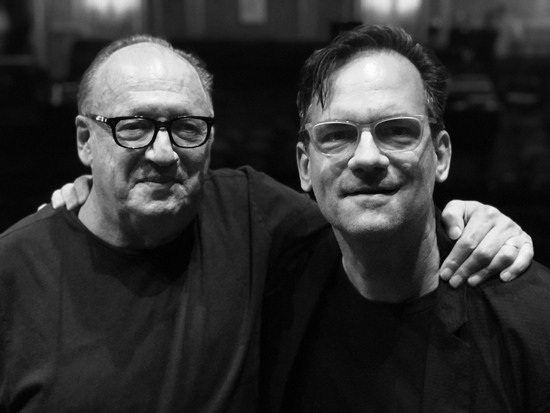
Jon Landau and Thom Zimny - photograph by Rob DeMartin
Citing numerous conversations about camera angles, movie references, and overall style, Zimny credits producer Jon Landau with a great deal of influence on the film. Take the opening — going from black screen to Springsteen's face in an instant. "It's not the detached thing of seeing Bruce walk onto the stage," Zimny says. "It's just lights up, he's talking, you're in it. That was a very conscious decision, something that I spent a lot of time talking to Jon about. We both like to reference classic cinema and even silent films; with this I was going to The Godfather, the way that it opens with a speaking voice, and you slowly pull back to reveal the room."
We're back in close-up for "Long Time Coming," and for good reason. Springsteen appears overwhelmed, and the film plainly shows those feelings apparently so close to the surface: each twitch, each eye rub, each quiver of the lip. Despite the song's infrequent inclusion in the show, "Long Time Coming" is a major beat in the film. The moving, heartfelt performance provides an uplifting third act to the story Springsteen on Broadway tells about his father, after the towering figure on a barstool (with "the haunches and ass of a rhinoceros!") and the depressed and threatening figure at the kitchen table in the dark. "My father was petitioning me for an actual role in my life," Bruce says here, "after being a ghost for a long time." As a viewer, it feels like a privilege to be so close for this moment. It's almost like being there.
At times, it's better than being there — the cameras go where we can't, where we might wish we could, were we sitting in the stalls. They slip through that fourth wall and provide close reads of a telling look, a gesture, a faraway gaze, shifting perspectives from front-and-center to across the lid of the grand piano. But always, always in service of the story and in keeping with the mood — and at their best, capturing the ineffable.
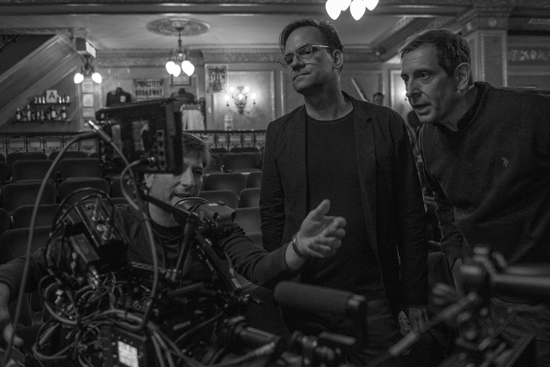
Thom Zimny with DP Joe DeSalvo (R) and camera operator Jay Feather (L) - photograph by Rob DeMartin
The filmmaker has been working closely with Springsteen for two decades — as editor, director, and co-director (Hunter of Invisible Game) — and has been a fan far longer than that, and it shows. Zimny's ability to capture and present important beats so effectively comes as much from his experience observing Springsteen's general craft and style in performance as it does from his familiarity with Broadway itself. I asked Zimny how many times he saw Springsteen on Broadway, in preparation for making his film. His reply: "I'm not sure, I'll need to ask somebody... I lost count."
"I was able to study the show for months," Zimny says, "and I also spent a lot of time listening to the audio, listening to how Bruce was honing the performance and changing small details. Like the guitar chords that he plays 'wrong,' when he describes first learning to play the guitar: how many times he plays the chords, what chords he plays... all that stuff was changing constantly until he got it to a place that was rhythmically right."
The director's vision for the film is rooted in his experience as a documentarian. "I really didn't want this to be cut like a concert film, and I didn't want it to be shot like a concert film," Zimny says. "I treated it more like the narrative work that I've been part of, like The Wire and other films with dramatic scenes. I just wanted to get away from the language of concert film," he emphasizes, "or comedy show, anything approached like that."
That preference informs not only his choices of what to show, how to show it, and how to cut, but also what not to show. You might notice — or, even better, you might not — that the camera never cuts away to the crowd. You don't see the audience until the final moments of the film, let alone zoom in on a laughing face in the crowd, or some rapt couple, the kinds of things you'd see in a comedy special. You're watching the show, not watching someone else watch the show.
That choice grants the viewer the ability to become lost in the performance, as you would in a seat at the Walter Kerr. It's an immersive film, the focus solely on the unfolding action on stage.
"For me as a filmmaker," Zimny says, "all the great concert films that I love don't really use audience in that way for a reaction. Stop Making Sense, The Last Waltz — only at the very end do you get a sense of the crowd. It makes the film a bit timeless in some ways, and you're not forcing either the humor or the emotions."
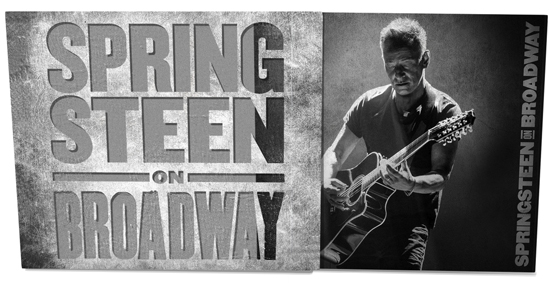
For fans who attended an earlier performance, of particular interest will be seeing how the show evolved as Springsteen became more comfortable with what he had written to perform. Generally speaking, settling in allowed him to loosen up, and to let his sense of humor shine through. Laugh lines may have changed from night to night, but you'll find far more of them here than before the run was extended. The whole thing has been honed, pruned, and allowed to blossom.
Portions of the narrative expanded, too. Talking about the effect of Alzheimer's on his mother adds new resonance to "The Wish" ("you'll know me in a glance"), and descriptions of friends lost to the Vietnam War bring them to life on stage. Originally just mentioned by name, his recollections of his hometown heroes the Cichon brothers and Castiles drummer Bart Haynes are fleshed out to form a set piece, peppered with humor, love, and a fine rendition of the "Wipeout" drumbeat.
Over the months, Springsteen refined the music, too. "Born in the U.S.A.," already a stripped-down bottleneck blues when Broadway began, emerges from the crucible even further melted down, with whole verses delivered completely a cappella. Springsteen has always been a surprisingly serviceable piano man, even in Roy Bittan's shadow on the E Street stage, but sitting down at the keys nightly did wonders for his performances on songs like "The Wish," "Tenth Avenue Freeze-out," and "My Hometown," played with power and confidence.
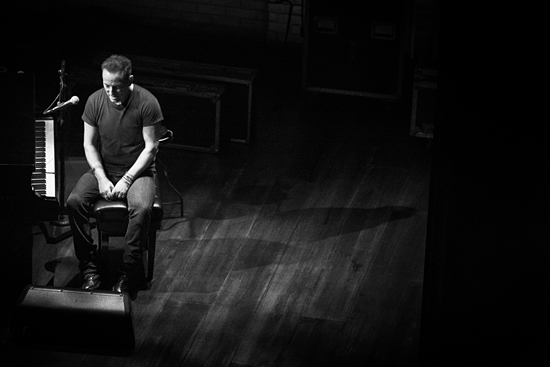
photograph by Danny Clinch
After just a short time with the soundtrack in hand, I'm surprised how well it holds up to repeated listenings. With introductions indexed separately from songs (as best as they can be divvied up, at least), it might be tempting to create a playlist of the music alone. But hearing it all straight through reminds me of listening to favorite comedy albums as a kid, rarely getting tired of hearing the same stories again and again. And there are instances when the music is absolutely inseparable from the spoken narrative, particularly with a song like "My Father's House" — never as powerful as when the song is cradled and surrounded by Springsteen's memories and dreams of his father, as it is here.
As a live document, the soundtrack is unlike anything in Springsteen's catalog. As acoustic shows go, not every performance here feels definitive. Finding new rhythms and new lyrical cadences — and perhaps on some level making sure no one can sing along — there are times when Springsteen's vocals get so far ahead of the beat he's maintaining on the guitar, so deep into the pocket he may never come out. On "The Promised Land" it feels like he'll soon lap himself. In the film, "Land of Hope and Dreams" is accompanied by a standing ovation, and it's easy to take that cue and root on the performance. As isolated audio, though, from its origins as a beat-driven anthem, the song here drifts further into dreamland; for my money, it loses some of its appeal. If you didn't know that everything Bruce does is so damn deliberate, you might think he rushed.
On the other hand, this acoustic "The Rising," with its chiming guitar, is one for the ages. Springsteen's intriguing piano interpolations and soulful vocals on "Tenth Avenue" make it a knockout, even before his moving tribute to the Big Man. "Born to Run" in this acoustic form is borrowed from the Tunnel of Love Express tour, and you can compare it to the live rendition released on Chimes of Freedom. Thirty years later, it's more urgent, more alive. His voice may be gruffer, but the wistful take on his signature song is definitive here.
The introduction to "My Hometown" features a repeating piano figure that is essentially the only "new" music in Springsteen on Broadway — I think of it as the "Freehold coffee smell" music — and it's beautiful and evocative, a lovely backdrop for mixed memories of his hometown. I still get goosebumps when the piano intensifies as Bruce proclaims, "Now, when it rains in Freehold..." In the film, stay tuned for the credits to hear this track as a pure instrumental.
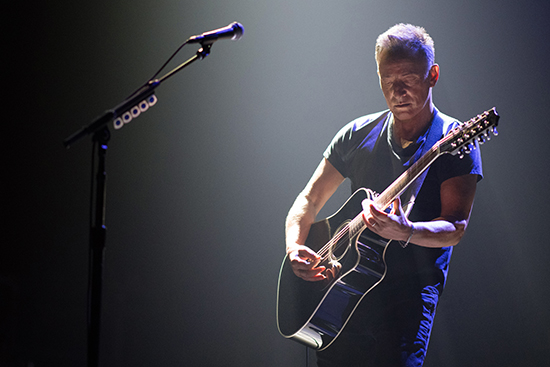
photograph by Rob DeMartin
When Springsteen goes solo for special events like this, he tends to offer a humanizing peek behind the veil. He dwells on the mysteries of identity, self, and what we present to the world, from the first night of the 1990 Christic Institute benefits (Call: "We love you, Bruce!" Response: "But you don't really know me.") to 2005's VH1 Storytellers (Caught out at a strip club: "I am simply an errant figment of one of Bruce's many selves.... Bruce does not even know I am missing. He is at home right now doing good deeds").
In Springsteen on Broadway Bruce admits, "I don't want to see my real self — why would others want to?" The demythologizing comes early. "I come from a boardwalk town," he says up front, "where everything is tinged with just a bit of fraud... so am I." He exclaims that he's found great fame and fortune writing about things "of which I have absolutely no personal experience." (With a punchline that only developed later in the run: "That's how good I am... I made it all up!") Part of this particular magic trick is that, in ostensibly stripping away a layer of bullshit, Springsteen is likely only revealing yet another "errant figment" of his many selves. But it makes for a hell of a show.
Whatever the core reality of his selfhood may be (if there is such a thing), however much "Bruce Springsteen" is a construction, this is the Bruce Springsteen that we know, as fans. The stories, the darkness, the hope, the humor, the showmanship, the stuff that makes us feel connected to each other and to the deeper part of ourselves... it's all here.
Not to get too fanboy on you, but every once in a while — think Super Bowl XLIII — the world at large gets to see what we see. Not the cartoon image of Broooce that many have had in their heads since the '80s, who pops up every once in a while on the cultural radar, but the long-haul, deep-cut, many-layered, richly gifted writer and performer who inspires this thing of ours, this passionate following. A basic delight in watching Springsteen on Broadway as it reaches the masses is imagining all those — TV bingers, Netflix-and-chillers, casual fans, fans-to-be — for whom this performance will be absolutely revelatory. For all of us, it's a treasure. Consider yourself Verified.






